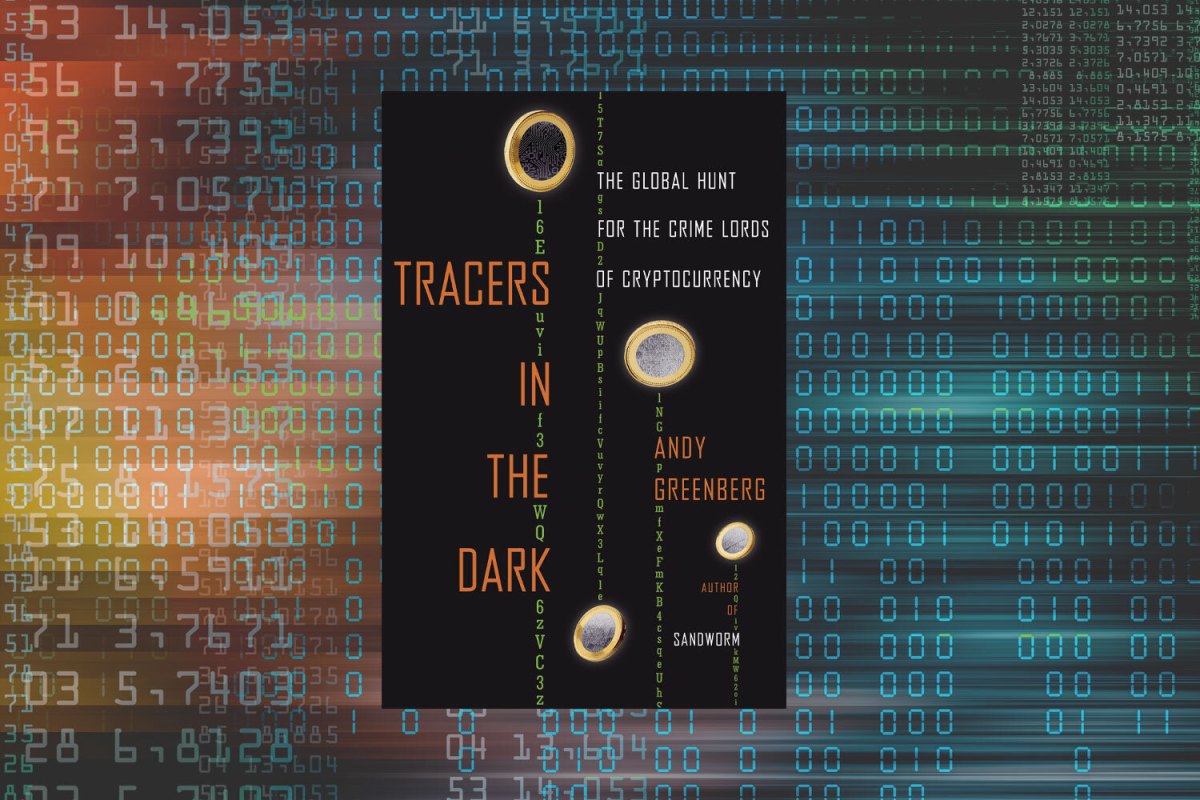To read journalist Andy Greenberg’s new book Tracers in the Dark: The Global Hunt for the Crime Lords of Cryptocurrency is to be immersed in a particular corner of crime and punishment. Greenberg, who’s been writing about hackers, cryptocurrency and the dark web for years, expertly chronicles the efforts of law enforcement to use information on the blockchain to track down suspects in a host of criminal cases.
Because of the history of cryptocurrency, though, that pursuit faces a number of technological challenges and raises some of the same questions that crypto enthusiasts have pondered for years. Greenberg’s book is often thrilling, but it will also leave you with plenty to think about once you’ve finished it — making for the best kind of page turner. InsideHook spoke with Greenberg about the origins of this book, its connection to his other works and what he thought of the ongoing collapse of FTX.
InsideHook: At a couple of points in Traces In the Dark, you talk about how you had interacted with some of the people you’re writing about before while writing previous articles. I was curious — when did the idea for this particular book first come together?
Andy Greenberg: I’ve covered this world of hackers and cybercrime and surveillance for 15 years, and I’ve always been interested in the world of online anonymity and the ways that tools like the dark web create a kind of fascinating drama of people trying to become someone else or stay a step ahead of law enforcement. In 2011, I came upon what appeared to me to be a kind of new phenomenon in that world, which was Bitcoin. Bitcoin was sort of introduced to me as a cypherpunk invention. The cypherpunks were this movement of mostly very libertarian encryption advocates who thought that they could use these privacy tools to take power away from the government and give it to individuals.
Bitcoin seemed to be, at the time, this kind of cypherpunk holy grail of a way to not just communicate anonymously, but to spend money anonymously. It appeared to be an actual anonymous and even untraceable currency for the internet. I spent more than a decade writing about the ways that cryptocurrency has been used for all manner of crime, from enormous thefts to narcotic black markets to even ransomware and human trafficking. But it was only in 2020 that I had this epiphany that Bitcoin was the opposite of untraceable. I had hints of this all along, but it honestly took me like, 11 years to fully see how opposite of correct my initial assessment of Bitcoin was, and that actually it is extremely traceable.
What gave you that epiphany?
I’d read the research papers over the years, I’d seen evidence that cryptocurrency could be traced, but it always seemed like if you were clever enough, you could use it in a way where you stayed a step ahead of the tracers. But in 2020, I started to see these Justice Department announcements.
I began to see this one company Chainalysis credited in one Justice Department announcement after another of like major cybercrime busts. Initially I thought that maybe I’d just write something about Chainalysis. I very quickly began to see that there was actually a bigger story here that stretched back years, and that Chainalysis had been involved in many of the biggest cyber criminal takedowns of the decade. And that beneath the surface, this cryptocurrency tracing had been this secret weapon, to some degree, that had enabled this small group of detectives to make one massive bust after another, each bigger than the last. That’s when I saw that there was a book to write and started to begin the long process of making inroads with not just Chainalysis, but the agents and prosecutors and ultimately, some of the criminal suspects, involved in those cases.
You focus on different cases throughout the book, so I was curious about whether you saw the book as a series of case studies in cryptocurrency and crime, or if you saw it more as one big story?
I don’t want to flatter myself, but I hope that the book reads kind of like The Wire, where every season is about a different criminal case, but there’s always the same unlikely team of detectives at the center. In The Wire they had wiretapping as their central investigative tool that broke each of those cases. And in this, it’s essentially like wiretapping cryptocurrency, following the money, tracing cryptocurrency that led to one massive case after another. It was always that some characters come in and others drop out, but there is a kind of core group. In particular one guy Tigran Gambaryan, this IRS criminal investigator who was involved in every single one of these cases.
As a writer — not to get into the sausage-making, but — you want an economy of characters. You want as few names as possible and you want a central protagonist. I was lucky to find that Tigran was exactly that, and not only the Forrest Gump of this story who touched every case and often was there at the most crucial moment in each one, but also was just a fascinating guy who was this bizarre mix of forensic accountant, aggressive gun-carrying federal agent, chip-on-his-shoulder post-Soviet immigrant and computer nerd all in one.
Earlier, you were talking about online privacy and privacy issues. I can think back to when I was first on the internet, when Usenet was a big deal and you could be fairly anonymous there. Do you think that cryptocurrency and the dark web represent a significant turning point when it comes to privacy? Or were there stages leading up to that?
If you look at the history of the cypherpunks, the group, um, of that I mentioned earlier — I wrote a book about them. My first book is about how WikiLeaks came out of this movement of cryptographers and crypto-obsessives. And you can see that like this group are the forefathers — that sounds like a gendered term, but there so many of them were men — for better or worse of so many of the privacy tools that some of us use today.
The cypherpunks’ inventions led to things like VPNs, which allow you to hide your IP address as you browse the internet. And then to Tor, which is a far more powerful anonymity tool that routes your traffic through three hops around the internet and layers of encryption. They did give rise to WikiLeaks, which was this innovation in granting anonymity to journalistic sources and leakers of classified information. I mean, Julian Assange was a cypherpunk. And they of course gave rise to the dark web too, and all of that. I think the privacy that those tools grant is all real. It is possible to be anonymous to some strong degree on the dark web.
In some ways, the fatal flaw of this whole dark web economy was none of those things, but but cryptocurrency, which was promised to be another one of these cypherpunk tools initially, but turned out to be the way in the way to crack that untraceability and anonymity of the dark web in many cases. I know that, whenever I say that cryptocurrency was promised to be untraceable or anonymous, I always imagine like all the haters on Twitter who are going to say, “Only an idiot ever thought that.” But I have to remind people that even Satoshi Nakamoto himself or herself, the mysterious creator of Bitcoin, wrote in the first email to the cryptography mailing list that introduced Bitcoin that among the features of this invention was that participants can be anonymous. That is a direct quote from that email.
I guess that’s true in some sense, but the only participant who’s ever really managed to stay anonymous, it seems, is Satoshi himself or herself, who amassed a million bitcoins and never spent any of them. And that might be like the only way it turns out that you can actually have practical privacy with Bitcoin.
The release of this book has coincided with the collapse of FTX. Do you feel like that has had any bearing on the law enforcement aspects of monitoring cryptocurrency that you’ve written about here?
The SBF case is really interesting. When the story first broke, it seemed to me to be a kind of 2008-style financial meltdown based on irresponsible investments and overleveraging, maybe a worse kind of Ponzi scheme. But then it turned out that something like half a billion dollars, hundreds of millions of dollars’ worth of FTX’s cryptocurrency was also just flat-out taken out of its accounts just after it declared bankruptcy. That money is like the loot in a crime of some kind, and it can be followed around the blockchain. The same crypto tracers that are the subject of my book are following that money in real time to try to determine where it goes and who stole it.
I think that it’s probably pretty likely that they already know the answer, in fact, and that we may find out pretty soon. The really interesting thing about the answer to that mystery is that it will hopefully reveal whether these were external hackers who were just taking advantage of the chaos of FTX’s collapse, or if they were insiders, like somebody who worked for FTX who was essentially embezzling this money, perhaps like trying to make themselves whole as they lost hundreds of millions or billions of dollars in this bankruptcy.
The fascinating thing about cryptocurrency though is that we can all watch that drama unfolding in real time. Many people are right now; I’ve written about this and I’m continuing to follow that money along with all of the tracers. It will be very difficult to steal it in a way that does not identify the thieves.
Over the course of the book the levels of crime that you’re talking about seem to get more and more pernicious and horrific. Halfway through the book you mention people using the dark web to buy fentanyl, and one of the later cases focuses on the abuse of children. Did you intentionally structure the book to show sort of activities getting deeper and more and more immoral over the course of the narrative?
It’s an interesting question. You can observe in the history of these technologies that they started with this political movement, the cypherpunks, where some of them had pretty nutty ideas about crypto-anarchy and even trying to enable that sort of lawlessness. But they came from an ideological place. The first drug web drug market, the Silk Road, was run by this guy, the Dread Pirate Roberts, who I interviewed and who had real ideals about trying to foster this black market for victimless crime. He was a radical libertarian who assigned people to read Austrian economics books in a book club on the Silk Road. But when the Silk Road was taken down, it was replaced by a succession of sites where the technology set the rules more than any ideals.
That, I think, paved the way for people to use that technology in more and more cutthroat, profitable and amoral ways. Ultimately, Alpha Bay became 10 times the size of the Silk Road and had almost none of its ideals or rules around victimless crime. I’m not sure why the progression continued in this way, but it did. And that is where the final major case that I describe in the book, this child sexual abuse materials video called Welcome to Video comes in, and it truly is the darkest layer of the dark web that I have encountered.
You end Tracers In the Dark on a somewhat ambiguous note with respect to the work that Chainalysis is doing and whether it is being used more for law enforcement or by financial institutions in a different capacity? You spoke with one of your sources, Sarah Meiklejohn, who opted to step back from law enforcement and exist in a more neutral space. Did your perspective on some of these issues change over the course of researching and writing it?
When I started out on this book, I had never actually told any story — of this size, at least — from law enforcement’s perspective. I guess I’ve been more interested in telling these stories from the perspective of the subversive, the criminal, the dissidents — the target of surveillance who was trying to evade the cat in this cat and mouse game. I just wanted to include all of what you just described as a kind of corrective. I didn’t just want this book to be a kind of cops and robbers story or to just tell this heroic story of federal agents and prosecutors and chain analysis taking down bad actors. I wanted to show that there’s another side to this and that financial surveillance isn’t always an entirely good thing.
Sarah Meiklejohn, the inventor of so many currency tracing techniques, she has her own really strong ambivalence about the ways that her innovations have come to be used. I found that to be really interesting, but also really helpful to me as the writer to use her as the conscience of the story. I think somebody had to be, and I’m just glad that she was.
Since you’ve finished writing the book, is there anything that has taken place in the world of crypto that you would say has had a major bearing on this that you think would have made it in had Tracers In the Dark been released a year later?
It’s always dicey to be writing a book about events that are unfolding as fast as this world of cryptocurrency crime does in particular. Just as the book was about to go to press is when the case broke of these two New York alleged money launderers that got a lot of attention because the woman in this couple had made these egregiously cringeworthy hip-hop videos that she put on YouTube.
That case also broke every record for not only cryptocurrency seizures, but actual monetary seizures of any kind in the history of the Department of Justice. And I only barely managed to get that case into the epilogue, even though [the investigation] was carried out by some of the central characters of the book. And then the Department of Justice announced another case that is now the second biggest seizure of cryptocurrency in history and you know. So this golden age of cryptocurrency tracing is not over.
The IRS criminal investigators who are the subjects of this book and Chainalysis, they keep outdoing themselves and breaking their own records and now have carried out the first, second and third biggest seizures of money of any kind in American criminal justice history.
I feel like I’m lucky to have found a logical endpoint to the story, and, and that is when Tigran Gambaryan leaves the IRS, since the story is so much about him. But of course this, in this world of cryptocurrency, cats, and mice, that game goes on.
This article appeared in an InsideHook newsletter. Sign up for free to get more on travel, wellness, style, drinking, and culture.
























